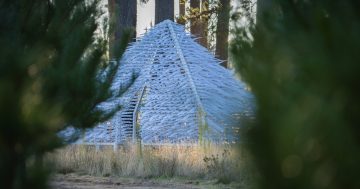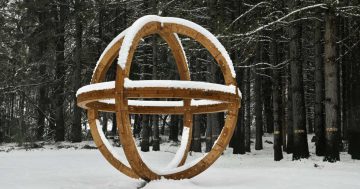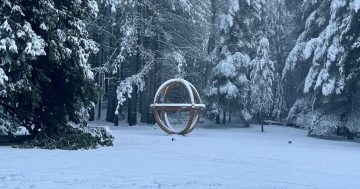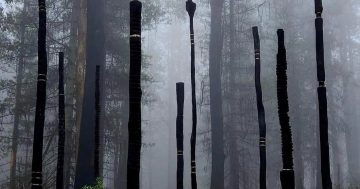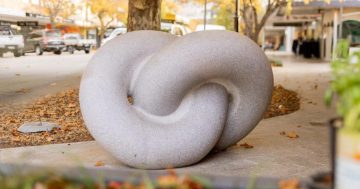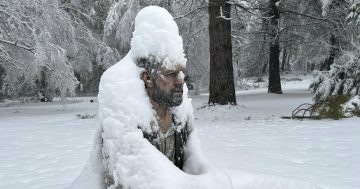
Jenny Blake’s exhibition in Tumbarumba, Threads, is a validation of what was lost, an acknowledgement of what has changed and a reminder that trauma lives unseen. Photo: Sculpture by the Sea.
Jenny Blake could, any day of the week, be immersed in checking, mustering or feeding cattle, perhaps fixing the odd fence. Other days she’ll be wrangling wire into other shapes, as an art form.
She could also be wrist deep in clay, florists foam, foil, photographic prints, charcoal and cold-press paper, forging works masterfully fashioned using found objects, steel rods or thread.
For the past few months, her hometown community of Tumbarumba has seen what that can look like thanks to that eternal patron of art in the Snowy Mountains – Sculpture by the Sea – which mounted an exhibition of Jenny’s work in a shop just off the town’s main street, The Parade.
The exhibition, titled Threads, doffs its cap to the almost invisible but stable, durable filaments that connect the community.
It is, in part, a lamentation and a commemoration of the scarring impact of the Dunn’s Road/Green Valley megafire that swept through the Snowy Valleys in 2019-2020, impacting more than 600,000 hectares across the NSW south west slopes and northern Victoria.
Forty per cent of national parks in the region were burnt, as well as 30 per cent of state forests.
Within the Snowy Valleys LGA, 800 ratepayers were directly affected, with more than 100 homes and buildings lost and more than 8000 stock losses.
But Threads, says Jenny, has a universal meaning in validating that which is lost, acknowledging what has changed and reminding us the experience of trauma is diverse and lives unseen.
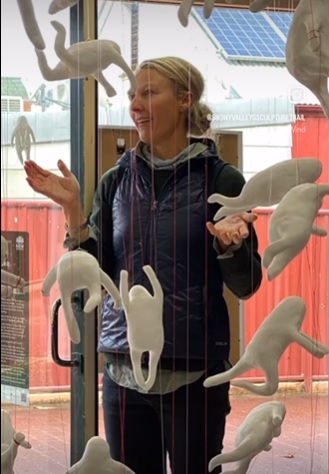
Jenny Blake gave an artist’s talk during her exhibition and ran sculpture-making workshops at Tumbarumba Public School. Photo: Jenny Blake.
It’s a prompt, she says, to remain connected, keep close, and support those around you even when you feel held.
Jenny’s interpretation of the free-falling, bottomless disconnection felt by the small community in COVID post-fire isolation – plummeting small white figurines suspended in time – commands the central point of the exhibition.
“In this area, around 100 homes were lost to the Dunns Road bushfire,” Jenny said. “One hundred figures hang in a void but remain suspended, united and sustained by connecting threads.
“Some are taut, strong, indispensable. Some lenient and relaxed but the strands represent reassurance, encouragement and connectivity. Bonds, coping mechanisms, threading through the community, suspending.”
This is backdropped by images and representations of the towering, majestic Sugar Pine Walk, near the mountaintop town of Laurel Hill – which perished in the fires – a spot that was, to Jenny, a childhood sanctuary.
For locals, the century-old sugar pine forest, an almost secret, sacred drawcard for many visitors to the area, served as a place of contentment, calm and still, Jenny says.
She says having images of the forest as part of the exhibition served as a final salute to their magnificence and she’s learned requests have been made that they be retained by Snowy Valleys Council.
“Having these as part of the exhibition has made me realise just how significant the loss of this plantation has been to the community,” Jenny told About Regional.
“It has unfortunately been decided they will not be reinstated on their original inclining site.
”The natural fall of the land was the principal element in intensifying their stature, their presence, forming a natural cathedral.”
But, she asks, when a new stand of pines grows elsewhere, will they be the same?
With each altering incident, change is inevitable, she says, and seeking positives, however minuscule, is challenging.
This she has demonstrated through the use of charcoal salvaged from the floor of the destroyed forest and then used in portraits.
A final and unseen embellishment is music, sourced internationally by Jenny, to underscore the experience with healing at the miracle Solfeggio frequency 528Hz, said to promote healing.
Hers is a message of coping with change – in relationships, bonds, the need for new sanctuaries and recognising what sustains you, what can help and hold up others.
After studying for a Bachelor of Arts (Visual and Design) at the University of Newcastle and a Diploma of Computer Art at Hogskolan i Skovde, Sweden, Jenny worked in art and design in Sydney.
Stints in Singapore and then Norway were studded with return visits to Courabyra, where she would work on the family farm.
After returning home for good, she practised art while studying for a Diploma of Education (Visual Arts and Design/Technology) at Charles Sturt University, where she would later lecture and teach.
Jenny has held several successful solo exhibitions in Wagga Wagga at both the Links and E3 art space. She’s also previously exhibited with the Sara Roney Gallery and The Harrison Galleries in Paddington, Sydney.
She presently assists with the operations on three family farms scattered throughout the Riverina, juggling her art in its various forms.
Threads has been on exhibition at 30a The Parade, Tumbarumba, in recent months and next week moves to a new space in Tumbarumba, at 11 The Parade, for an extra two months.
These exhibitions form part of the Shop Art Projects, which are the most transitional spaces on the Snowy Valleys Sculpture Trail.
Four long-term unoccupied shops in Batlow and Tumbarumba have been leased for commissioned artists to install site-specific artworks, contributing to the activation of the streetscapes and creating another reason for people to visit the towns.
During the artists’ installation, they stay in the Snowy Valleys and engage with the local community, with free workshops and talks.
During Threads, Jenny ran sculpture-making classes at Tumbarumba Public School and said she was impressed with the knowledge the students had of the sculpture trail, and the certainty of three students they would be sculptors when they grew up.
The exhibition is open every Friday from 11 am to 2 pm.







